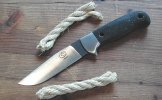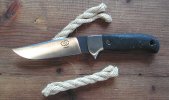- Joined
- Jan 21, 2000
- Messages
- 8,888

When it comes to developing high-performance blades, knife maker Gayle Bradley of Weatherford, TX has a very impressive track record (www.bradleysblades.com). As a founding member of BladeSports International, he's had the opportunity to consult at length with some of the best engineers and metallurgists in the business at companies like Crucible, Carpenter Steel, Peters Heat Treating and others, in the development of extreme performance blades. His experience runs the gamut through every aspect of steel, geometry, and heat treat plus testing in live competition. He has done two collaborations with Spyderco to date, and is always developing new projects.
Although he makes primarily high-end folders these days, Gayle still has fire in the belly for extreme performance fixed blades. In conversations over a few weeks last winter, I was delighted to learn that we see eye-to-eye on many performance aspects of knives in general and hunting knives in particular. He recently honored me by building a high-efficiency cutter in his favorite CPM M4 steel, based on my hunter design:

Overall length is 10" with blade length from bolster to point of 5". My original sketch:

Compared with my original design, this one rounds off the bird's beak at the butt and has a full/tapered tang, as he's using the same construction method used on his competition cutters, including HSM (horse stall mat) slabs for the handle (wonderfully comfortable and secure). From my sketch, he incorporated the downward angle of the edge as it comes off the ricasso, which preserves the deep belly I prefer for skinning, but he lengthened the clip for a finer point, which I find I like. Instead of a conventional guard, he used double-pinned, tapered bolsters which are very comfortable, especially when choking up. He even heat treats the 416 bolsters, by the way. The knife balances on the rear edge of the bolster--just right.
Over the course of setting many cutting records using his own knives in BladeSports competitions, Gayle has refined both the heat treat and high-performance grinds achievable with M4 to an amazing degree. Blade thickness on this hunter is .14" at the spine/ricasso, with distal taper forward from the plunge, flat ground to about .005" edge thickness in the forward part of the blade. The angle for the master grind (primary blade grind), which Gayle calculates precisely prior to grinding using a trigonometry formula, is only about 7 degrees included. Heat treated with an innovative directional air quench Gayle developed himself, the hardness is 61 HRC.
For quality control, he cut an extra M4 blank of the design, finished and heat treated the blade, and tested it by applying pressure across a 3-inch span of the blade with a 1000 lb. press, achieving enough deflection to assure the blade would not break with hand pressure alone. To check the grain structure in the steel, he then took that blade to destruction by adding pressure with a cheater bar until the knife finally broke under an estimated 1700+ psi. The grain structure at the break was as pure as it gets. I've never known a maker to go to these lengths to test a blade design and heat treat before sending a knife to me.
I had intended this to be a pure cutter--a meat and hide razor--and it is. From early testing I've done on hard sisal rope, I would subjectively put it among the top three knives in cutting efficiency I've ever experienced. Gayle opted to leave the rear part of the edge at about .015" for added strength, which is about the same edge thickness of his big competition choppers--still "high-performance thin" by most makers' standards, even for smaller knives. His thinking was that if I were hunting in the "outback" and had to rely on the knife in a survival situation, I could baton this one through whatever I need to without fear of failure. As I said, I'm very impressed with the aggressiveness of the edge, and have ordered another like it that should be even more impressive using a similarly thin primary grind to an edge thickness only about half this one--under .003".
I know I'm getting obsessive/compulsive here with extreme cutting geometry. But given that CPM M4 is the toughest high speed steel Crucible ever produced (see * below), and with Gayle's years of experience and testing on M4 to back up performance/reliability, I told him I didn't want to "leave anything on the table" in terms of high-performance cutting efficiency. When I promised not to chop bone or baton with this next one, he chuckled--then agreed.
To say I'm pumped about these knives would be an understatement--maybe you can tell?
* From Crucibles information sheet on CPM High Speed Steels: " CPM M4 is the toughest high speed steel we produce and is surpassed in wear resistance only by CPM T15, Rex 76, and Rex 121."
The view topside:

Last edited:
